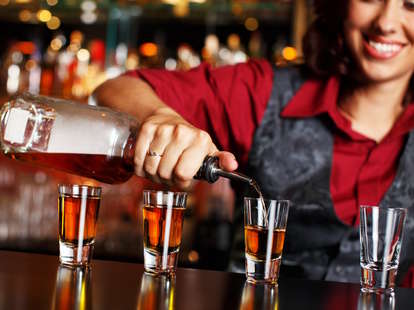

If you’ve ever given any thought to the oddities of bar terminology (a pastime mostly enjoyed after a few rounds at said bar), you may have wondered about the curious word we use for a small pour of liquor, the mysterious “shot.” Once commonly called a “jigger” of whiskey, the more common term “ shot ” is likely so second nature, you don’t even stop to think about it. But the word remains somewhat of enigma, as it popped up here and there in the English language before it entered regular usage sometime around the mid-20th century. We can’t quite settle the debate on the word’s origin, but here are a few theories.
The most likely origin for the word (and unfortunately the most boring) is found deep in Old English. In Nathan Bailey’s 1721 compendium, An Universal Etymological English Dictionary , Bailey says “shot” referred to “a Flagon which the Host gives to his Guest if they drink above a Shilling.” A similar note in Bailey’s dictionary for “ale-shot” indicates “a Reckoning or Part to be paid at an ale house,” aka a tab for drinking all that ale. About 300 years of etymological evolution can explain the shrinking of those shots down to a single gulp and the disappearance of the “reckoning” sense of the word.
So Anglo-Saxons were shooting their ale, their descendants were doing so from shots, and generations later, drinkers all over the world are doing shots of Fireball between games of beer pong. History really is a beautiful thing.
OK, enough boring etymology. On to the fun theories (that are total bull, but still pretty cool).
A few stories erroneously associate the term “shot” with the Old West. One claims that cowboys paid for their whiskey at the local saloon by trading booze for bullets. Another story comes from Dr. Jehu Z. Powell’s 1913 book, A History of Cass Country Indiana from its Earliest Settlement to the Present Time , which holds the title for first written reference to a “shot” proper. Powell claimed that in New Waverly in 1857, a barrel of “red eye” whiskey was sabotaged by local temperance forces who shot at the barrel to spill its contents before it could be served. “Ever after that,” Powell wrote, “when the boys wanted a drink they would ask for a ‘shot of red eye.’”
Another theory says that families who hunted their own game would place a “shot glass” on the table with dinner so diners had somewhere to dispose of the buckshot picked from their meat.
Back when every desk was equipped with quill pens and ink, writers needed somewhere to store their feathery writing devices. A “shot glass” filled with lead shot would hold them in place, ready for that next treatise on colonial drinking habits.
Chemist and glass technologist Friedrich Otto Schott opened a glassworks factory in the 1880s, where he helped develop tougher glass for scientific work (which subsequently lent itself to shot glasses tough enough to withstand general bar wear and tear). Americans, being uneducated Americans, simplified the moniker to “ shot glass ” when it arrived stateside.